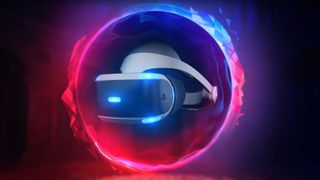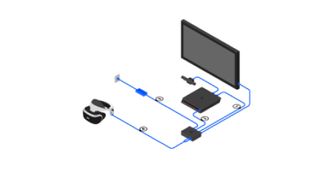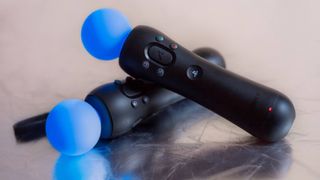PSVR 2 — here’s what Sony needs to fix for the PS5
Here’s how Sony can sell me on the PSVR 2

The PSVR is a seriously cool piece of kit. In fact, I vividly remember the first time I strapped the headset on and became overwhelmed with an almost child-like sense of glee at being instantly transported into the virtual world.
Yet, a year on since I bought into the virtual reality market, my PSVR rarely sees the light of day. It’s been squeezed into a plastic box and shoved to the back of my closet for the last few months. It only really comes out when some distant family member visits and I showcase it as a novelty.
- Everything we know about the PSVR 2
- Black Friday PS5 deals — the best early deals
- Plus: PSVR 2 design possibly teased by Sony patent — here's what it looks like
This is not to say I don’t believe in VR as a platform. Far from it. The PSVR has provided me with some of my favorite gaming experiences of the last decade, but the entry-level headset comes with too many drawbacks and caveats for me to use it consistently.
Nevertheless, when Sony announced the PSVR 2 my interest was piqued. I badly want to be an early adopter of this device. Partially because, as you might expect for someone in my line of work, I have a natural desire to own the latest tech, but also because I see so much potential in PlayStation VR and I don’t want that to be wasted.
However, before I'll commit my money on day one, these are the biggest issues with the current PSVR that Sony needs to fix for its successor to become the vital PS5 accessory I know it could be.
Keep setup simple
Perhaps one of the biggest reasons that my PSVR rarely leaves its plastic prison is that actually setting it up is unbelievably irritating. Anyone who owns a PSVR will feel my pain with this complaint.
Just to get the headset functioning requires connecting half a dozen wires into a whole range of places. Firstly you’ve got a wire that runs from the headset to a processor unit. Then, this breakout box must be plugged in a power socket, your television, and a compatible PlayStation console (via two different cables). You also need a separate camera plugged into your console and (ideally) placed on top of your television.

The process is even more finicky on the PS5. As the PSVR camera doesn’t directly connect to the PS5 due to the next-gen console lacking the required port, you must first order an adapter from Sony. The PS5’s own HD camera accessory isn’t compatible with the PSVR for some baffling reason.
Plugging in the PSVR is almost a game itself. Only the objective of this game is to see how long you can last before launching the headset across the room in frustration after accidentally plugging one of the cables into the wrong socket and having to start the whole process over again.
Of course, you could just leave the PSVR plugged in after the initial setup but I’d prefer not to have permanent cable spaghetti running across my living room. The overly finicky setup process is often why I don't bother using my PSVR even when I may be in the mood to play.
To just about everybody’s great relief Sony has confirmed that the PSVR 2 will “connect to PS5 with a single cord to simplify the setup and improve ease-of-use.” It might seem like a small upgrade, but it will make a dramatic difference in motivating me to actually use the device on a daily basis.
Too painful to play

Unfortunately, for as much as I admire the tech, I find the actual process of using the PSVR for lengthy spells a physically painful experience. When I use the headset for more than around 45 minutes, I begin to develop a wicked headache that sometimes takes hours to subside.
At first, I believed this to be a symptom of motion sickness which is common among newbies getting their VR legs, but have since come to realize it actually stems from the (relatively) poor resolution of the PSVR’s dual screens.
To cut a long story short, when using the PSVR, I frequently have to refocus and squint my vision in order to adjust to the blurry and jaggy images in front of me. This results in my eyes straining and headaches forming. For as much as I enjoy the sensation of being in a virtual space, the thrill wears off pretty quickly when your head starts pounding.
The current PSVR outputs a resolution of 960x1080 per eye, for comparison the Oculus Quest 2 offers a resolution per eye of 1832x1920. The PSVR is obviously an entry-level model in the VR market, but Sony badly needs to bump that up for the PSVR 2.
Thankfully, it appears the power of the PS5 will allow for a much-needed resolution jump. Earlier this year UploadVR reported that the PSVR 2 will have a resolution of 2000x2040 per eye. More than double the resolution on the original PSVR. This upgrade should allow for significantly clearer images, and give my eyes a well-needed rest.
Move on from the Move

The current PSVR headset makes use of the PlayStation Move controllers, and these motion wands are really showing their age.
Originally released to compete with the Nintendo Wii in 2010, the PlayStation Move controller has not aged gracefully. Aside from looking like an over-priced glowstick you’d buy at Disney World, the single-camera tracking offered is just not precise enough to compete with the level of control possible on alternative VR headsets like the HTC Vive Pro 2.
It’s been theorized that Sony retrofitted the PlayStation Move to become a VR controller in order to get rid of a mountain of unsold stock, but thankfully Sony has confirmed it won’t be iterating on them for PSVR 2.
In March, Sony showcased the new PSVR 2 controllers and they look like a dramatic improvement on the PS Move. These “orb” shaped controllers offer a high degree of free movement, adaptive triggers and haptic feedback, finger touch detection, and make use of a tracking ring, which should allow for vastly superior motion detection.

Plus, these controllers sport actual analogy sticks, which could make the point and click movement systems often used in PSVR games a thing of the past. This is another upgrade that might seem small at first but will be a game-changer when the PSVR 2 actually launches.
Rumors have also suggested that the PSVR will ship with a pair of controllers in the box, so every player will be using the same control scheme — which wasn’t always the case with the original PSVR as you could also use a DualShock 4 controller. This will allow developers to really take advantage of all the features of the controllers.
I’m extremely eager to learn more about the PSVR 2. Based on what’s been confirmed so far, and some of the rumors floating around, it could be the PlayStation VR setup I’ve been waiting for.
We don’t have exact release or pricing details yet, but Sony has confirmed the headset will launch in 2022, so it won’t be too long before we know more.
Sign up to get the BEST of Tom’s Guide direct to your inbox.
Upgrade your life with a daily dose of the biggest tech news, lifestyle hacks and our curated analysis. Be the first to know about cutting-edge gadgets and the hottest deals.

Rory is an Entertainment Editor at Tom’s Guide based in the UK. He covers a wide range of topics but with a particular focus on gaming and streaming. When he’s not reviewing the latest games, searching for hidden gems on Netflix, or writing hot takes on new gaming hardware, TV shows and movies, he can be found attending music festivals and getting far too emotionally invested in his favorite football team.
